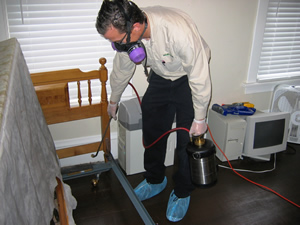Exploring the Scientific Research Behind Bed Insect Warm Treatments as a Sustainable Pest Management Method
In the realm of bug management, the pursuit for reliable and lasting options stays a continuous pursuit. One such approach that has obtained traction in recent times is using heat treatments to combat bed insect infestations. By harnessing the scientific research behind thermal fatality factors for these relentless bugs, heat therapies use a promising option to standard chemical-based techniques. The intricacies of just how heat effectively removes bed bugs and the wider effects for lasting parasite administration practices make this a subject worth checking out additionally.
Bed Pest Warmth Treatment Process

Thermal Death Factor for Bed Bugs
Subjecting bed bugs to elevated temperature levels past their thermal resistance variety is crucial for accomplishing reliable removal in warm therapy processes. The thermal death point for bed pests refers to the temperature at which these pests can not endure. Research suggests that bed bugs begin to perish when revealed to temperature levels over 113 ° F(45 ° C) for a sustained period. As the temperature level enhances, so does the death price of bed pests. At around 118 ° F(48 ° C ), bed bugs begin to die quickly, with a mortality rate of nearly 99% within minutes of exposure. This demonstrates the sensitivity of bed bugs to heats and highlights the effectiveness of heat treatments in eliminating invasions. By reaching and keeping temperatures above the thermal death factor for bed pests, parasite administration specialists can make sure detailed elimination of bed bug populations, including hard-to-reach locations where chemical treatments may be less efficient. Recognizing the thermal fatality factor for bed bugs is crucial for applying successful heat therapy strategies and achieving sustainable insect administration outcomes.
Advantages of Warmth Treatments
Having actually established the crucial thermal death factor for bed pests, it is critical to now discover the substantial advantages that warm treatments use in successfully removing these durable parasites. When compared to typical chemical methods, warmth therapies present numerous key benefits. Among the primary benefits is that heat can penetrate deep into cracks and crevices where bed pests hide, guaranteeing that also the most hard-to-reach areas are warmed to dangerous temperature levels. This thorough method not just eliminates real-time insects however additionally targets bed bug eggs, stopping future infestations.
In addition, warm therapies are non-toxic and eco-friendly, making them a sustainable pest management method. Unlike chemical pesticides, warmth therapies do not leave harmful deposits that can pose dangers to human health or the setting. This element is specifically essential in sensitive settings such as hospitals, schools, and domestic areas where chemical usage might not be desirable.
Additionally, heat therapies have a high success price in eliminating bed bug infestations in a solitary therapy, reducing the requirement for numerous visits and lessening disruption to owners. This sites performance not only conserves time and money yet additionally gives comfort to those handling bed pest problems.
Effectiveness of Warm Treatment

Research study researches have actually constantly shown the performance of warmth therapies in accomplishing a high price of bed insect death. Appropriately performed warm therapies can reach all the crevices and splits where bed insects might be harboring, making certain a comprehensive technique to extermination. Heat therapies have actually the included advantage of eliminating bed bug eggs, which are typically resistant to standard chemical treatments. In general, the performance of heat treatments in eliminating bed insect problems makes them a lasting and trustworthy insect monitoring technique.
Sustainable Parasite Management Conveniences
Executing sustainable insect monitoring techniques provides lasting benefits for both the environment and public wellness. By using techniques such as heat therapies for pest control, we can decrease the dependence on harmful chemical pesticides that can have damaging results on ecological communities and human health - DC exterminator. Sustainable browse around this web-site insect monitoring techniques assist in maintaining biodiversity by targeting specific bugs without damaging non-target microorganisms, thereby preserving a well balanced ecological community
Moreover, lasting parasite monitoring techniques add to the general health and wellness and well-being of the general public. By lessening exposure to harmful chemicals utilized in standard pest control approaches, heat treatments provide a safer option for insect management in domestic, industrial, and public spaces. This decrease in chemical use likewise assists in avoiding pesticide deposits from polluting water, air, and soil, protecting environmental quality.
Final Thought
In final thought, bed insect warm therapies have been revealed to be a efficient and lasting pest management technique. The thermal death point for bed pests makes them susceptible to warm treatments, which have various benefits over traditional chemical treatments. The performance of Get the facts heat therapies in eliminating bed bug problems while decreasing ecological influence highlights the capacity of this approach as a lasting solution for insect control.
The bed pest warm therapy procedure entails raising the temperature level within plagued areas to a level that effectively removes bed bugs and their eggs. By reaching and preserving temperature levels over the thermal death point for bed pests, pest administration specialists can ensure thorough removal of bed pest populaces, consisting of hard-to-reach locations where chemical treatments may be less efficient. One of the key advantages is that warmth can permeate deep into gaps and cracks where bed bugs hide, making sure that even the most hard-to-reach areas are heated up to dangerous temperature levels. Unlike chemical treatments that might leave behind resistant populations, warmth therapies offer a environmentally pleasant and non-toxic solution that can penetrate deep into furnishings, wall surfaces, and other hard-to-reach areas where bed bugs conceal.
The thermal death factor for bed bugs makes them vulnerable to heat treatments, which have countless advantages over standard chemical therapies.